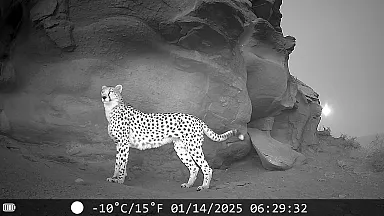
Saving the Asiatic Cheetah:
The rarest wildcat in the world
- Author: Morteza Pourmirzai
- Publication Date: August 05, 2025
- Focus Species:
The Asiatic cheetah, a symbol of grace and resilience, teeters on the brink of extinction. Fewer than 30 individuals remain in Iran. There are only six in captivity with the rest scattered across roughly 11,600 square miles of fragmented desert. Their survival is threatened by shrinking habitat and human encroachment as well as political constraints that make implementing effective conservation strategies uniquely challenging. Still, amidst adversity, a small group of committed conservationists continue the fight to ensure this remarkable species is not lost forever.
Cheetah habitat in Iran has been fragmented by the expansion of mines, roads, agricultural developments, and livestock grazing. These disturbances have carved up once-continuous landscapes into disconnected patches, increasing the risk of fatal road collisions and isolating the small remaining population. With insufficient resources and limited personnel to patrol such expansive areas, the challenge is immense.
A milestone in 2025 offered rare moments of encouragement. In Miandasht Wildlife Refuge in North Khorasan Province, camera traps captured an image of Helia, a five-year-old female cheetah, the first confirmed sighting of a cheetah in that area in six years. Having traveled 132 km from the Turan Biosphere Reserve, Helia is now the mother of two cubs born in 2024. Her presence in Miandasht where rangers and local people helped avert a road collision during her journey suggests that the refuge might once again serve as a safe breeding ground.
Yet political realities in Iran cast a long shadow. The government has a long history of mistrusting conservationists, and some have been accused of espionage under the cover of research. In 2025, following a 12-day war with Israel, these suspicions deepened, and restrictions on fieldwork, data collection, and NGO operations were further tightened.
Protecting this species will require hope as well as action. Conservation efforts to protect Asiatic cheetahs in the area include the development of water management projects to mitigate the effects of climate change, ensuring that wildlife has access to vital water sources. Community engagement and capacity development are also critical, and includes the training of new rangers and the development of educational materials and public awareness campaigns to strengthen community engagement and local pride in cheetah conservation.
Visit sarvinwildlife.com to learn more about our work.
Do You Have 2-4 Hours A Month To Preserve Your Local Ecosystem?
Our volunteers are the driving force behind making true change in ecosystem health and wild cat conservation. Some like to volunteer in the field, others help us maintain our online presence, and some work with events. With just a few hours a month, you can make a difference, too.
Make A Difference Right Now
As a 501(c)3 nonprofit, our work is only possible because of generous donors like you.
More than 90% of your donation will go directly to our groundbreaking research, outreach, and education programs.
This is where true change starts. If you’d like to be a part of it, make a donation to Felidae Conservation Fund today:
Or,
